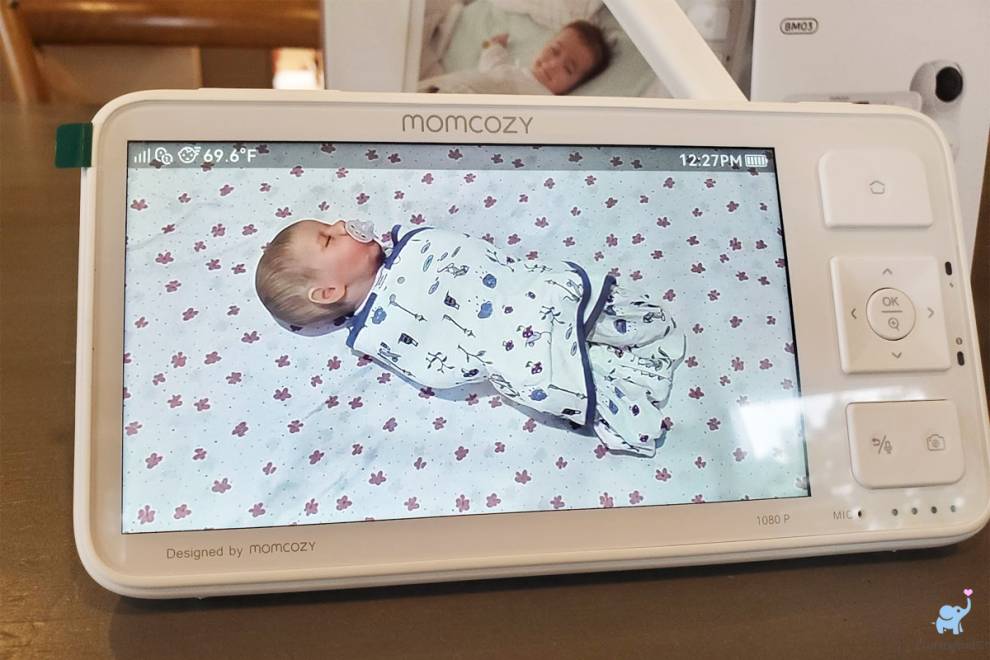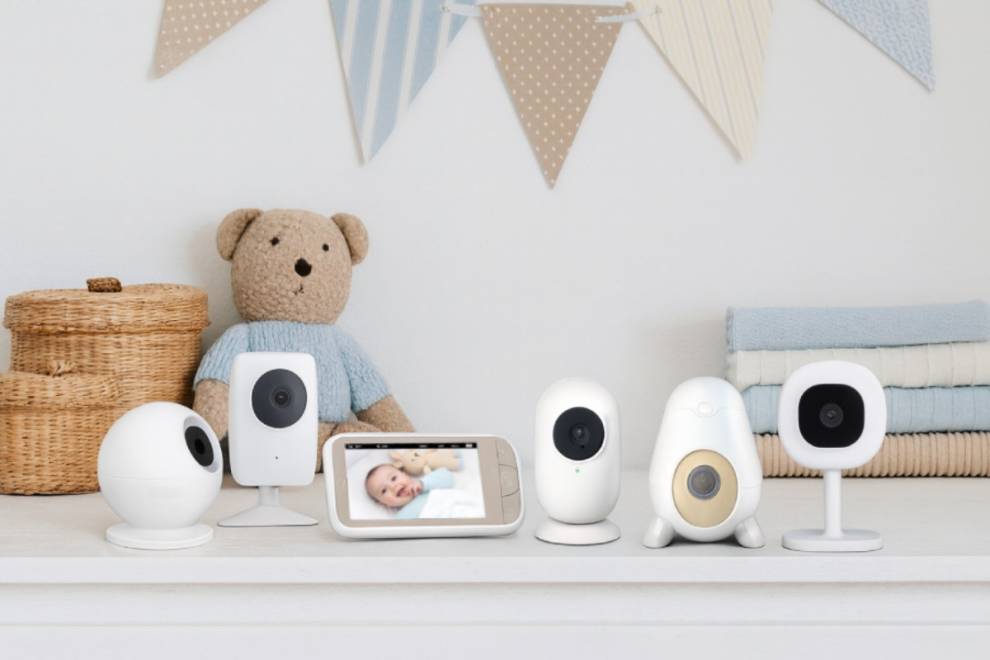We test the DockATot and give our honest opinions about its safety and quality.

Mommyhood101 independently tests and curates baby gear to help you make informed decisions. If you buy products through links on our site, we may earn a commission.
ALERT: As of November 2022, the DockATot Deluxe+ can no longer be manufactured, imported, or distributed to the U.S. due to infant deaths associated with its use as a sleep product. You can read more about recent baby product recalls here and see the U.S. CPSC DockATot announcement here.
We do not recommend purchasing or using a (new or used) DockATot with your child.
The DockATot is the most popular baby nest on the market, offering a comfortable place for your baby or toddler to lounge, practice tummy time, get a diaper change, play, and have a supervised nap.

When we first saw the DockATot, we were very nervous that parents would use it the wrong way: as an unsupervised sleeping area, as a co-sleeper, or placed into a crib or bassinet. We advise against those uses, even if you're watching your baby closely in person or with a baby monitor.
In other words, the DockATot is not a suitable replacement for an appropriately sized bassinet or crib mattress.
That being said, we think there are a ton of practical and cozy uses for a DockATot!
DockATot Pros and Cons
✔️ Adorable colors and patterns.
✔️ Lightweight & Portable.
✔️ Made in Europe.
✔️ Machine washable cover.
✔️ Breathable cover.
✔️ Oeko-Tex fabrics.
✔️ No phthalates.
✔️ No heavy metals.
✔️ Cozy and Comfy.
✔️ Not inflatable.
✔️ Meets US safety standards.
✔️ Comforts fussy babies.
✔️ Two stages for growing kids.
✔️ OK for supervised naps.
❌ Not suitable for travel.
❌ Not suitable for sleep.
❌ Expensive!
Overall, we believe the pros outweigh the cons by a fairly big margin.
Our biggest challenge with the DockATot is that parents don't read the instructions or use the product only as intended. They also violate the safe sleep recommendations of the American Academy of Pediatrics (AAP) and use them as co-sleepers. This is your prerogative as a parent and nobody can stop you from choosing to co-sleep, but there are safe and very unsafe ways of co-sleeping.
We review the safe and unsafe ways to use the DockATot later in the article, along with examples of ways that parents are using the DockATot in dangerous and inappropriate ways.
History of Baby Nests & Loungers
This isn't necessarily a new concept, it's just better executed with the DockATot.
In general, a baby nest like the DockATot is similar to Moses baskets, baby boxes (like the cardboard Smitten baby boxes), and baby pods. Moses baskets are typically made of wicker with handles on the top, and lined with fabric and padding.
Baby boxes are typically cardboard with a mattress placed at the bottom, and baby pods are more like nursing pillows with center support as seen with the old recalled Boppy baby loungers.
For those familiar with the Bible, Moses is said to have been left in a basket and set afloat along the Nile River (eek!).
That's the origin of the term Moses basket, and artists' depiction of that frightful scene usually shows something similar to a modern wicker Moses basket.

Fast-forward two thousand years and fortunately things have changed quite a bit!
First and foremost, you won't be sending your baby down a river in a floating basket! Second, these baskets have become a lot more comfortable, versatile, safe, and easier to clean and maintain.
The DockATot was known in Europe as the SleepyHead and then came to the United States in 2015. It's not alone in the market, with several companies making products very similar to the DockATot. Because most of them are recalled or discontinued due to safety risks, we will not link to them, but they include the: SwaddleMe By Your Side Sleeper, the Baby Delight Snuggle Nest, the Abreeze Bassinet Lounger, and the Smiling Gaia Baby Lounger Nest.
Each of these baby nests has its own pros and cons, and in our opinion, none is as comfortable and versatile as the DockATot.
DockATot Models: Deluxe+ & Grand
There are two versions of the DockATot, the Deluxe+ and the Grand. Early this year, we purchased both of them and put them to the test.
Here are the differences between the Deluxe+ and Grand DockATots:
| Age Range | Deluxe+: 0-8+ Months | Grand: 9-36+ Months |
| Weight Range | Deluxe+: 5-22 Pounds | Grand: 22-40 Pounds |
| Length (closed) | Deluxe+: 29" | Grand: 39" |
| Length (open) | Deluxe+: 34" | Grand: 48" |
| Max Width | Deluxe+: 18" | Grand: 24" |
| Side Height | Deluxe+: 7" | Grand: 10" |
| Mattress Thickness | Deluxe+: 1" | Grand: 1" |
| Carry Handles? | Deluxe+: Yes, 3 | Grand: Yes, 2 |
| DockATot Weight | Deluxe+: 3 Pounds | Grand: 5.5 Pounds |
| Avail. Monogram? | Deluxe+: Yes | Grand: Yes |
| Approx. Price | Deluxe+: $175-200 | Grand: $275-300 |
It was a bit challenging to measure the side height because it really depends on how much loft the padding has at the moment, so take those measurements with a grain of salt!
The biggest differences between the Deluxe+ and Grand are the recommended baby ages and weights, and their overall sizes.
The Grand is considerably bigger. and that size (especially the width) makes it much less suitable for co-sleeping (more on that later) than the Deluxe+.
The Grand is also a bit heavier, and much more expensive. The size difference between the Deluxe+ and Grand is about 33%, but the price difference is about 55% higher. So the price jump is a bit more than the actual jump in size.
DockATot Review
For our review, we tested the DockATot Deluxe+ and Grand with a 3-month-old baby (Deluxe+) and a 11-month-old toddler (Grand).
Initial Impressions. The packaging was beautiful. Given its high price, we were really happy with how it was presented in the box, and think it would work really well as a gift idea for new babies or as a baby shower gift.
Taking them out of their boxes, our first impression was that the cotton fabric was reasonably soft and felt durable and high quality. The DockATot embroidered logo looked elegant and didn't stand out too much. The side walls were soft while also supportive and breathable. DockATot offers embroidered monograms with your baby's name, but we didn't make the splurge!
The bottom pad is about an inch thick and feels like a variant of memory foam with a bit more firmness, which is appropriate. We found all of this to be true for both the Deluxe+ and Grand.
There were no strong odors or off-gassing like you find with some baby products, like crib mattresses. The product is not Greenguard Certified, though we were impressed with the lack of noticeable emissions.
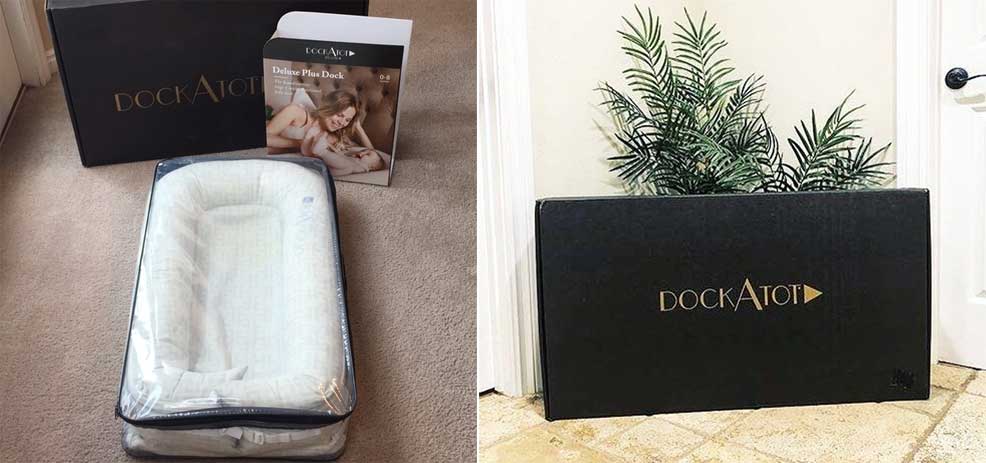
There were a few surprising things. First, it was much floppier than we were expecting for a product marketed towards newborn and infant sleep. We were expecting a much firmer mattress pad, and the side tubes to be a little more rigid than they are.
Second, related to the floppiness, the side batting in the Grand tended to become uneven and bunched up in certain areas. We're assuming this is because of the wider tube diameter and the use of loose polyester batting. Of course, the lumpiness can make it look a bit different than what you'd expect from the photos.
Setup & Use. Years ago, when we first saw the DockATot emerge on the market, we assumed that the side walls were inflatable.
On the contrary, we were happy to learn that there is no inflating or deflating necessary, and the entire thing is stuffed with polyester batting.
This does make it a bit heavier and less portable than an inflatable baby nest, but also way more comfortable.
The cool thing about the DockATot is that it's completely ready for use right out of the box, with no assembly required. The mattress pad and side tubes are already zipped into the cover, the bottom snap is closed, and it's ready to go!
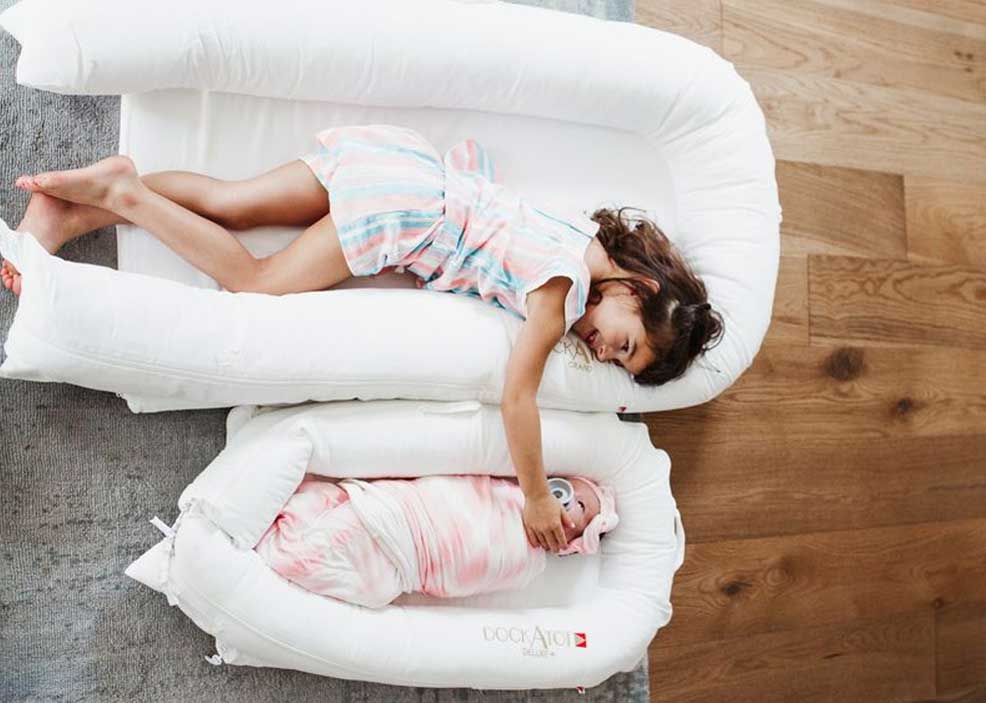
Honestly, the DockATot is super comfortable and cozy for babies, toddlers, and even bigger kids.
The raised sides give it a feeling of security and warmth that isn't found with a typical bassinet, crib, or activity mat. Combine that with a swaddle and you've got a super cozy pod! This is especially the case with the Deluxe+.
The Grand is really an entirely different beast and to be honest, my husband and I loved lounging and napping in it ourselves! The sides are like a giant pillow, and it's great for (adult) side-sleeping with one leg on a side and your head on the upper edge.
The cotton cover isn't as soft as we assumed it would be, but it's definitely good quality and comfortable against bare skin. At the upper edge of the DockATot where the tube curves, the cover gets a little bunched up (folded/creased) and is not entirely comfortable against the face (for example when side-sleeping).
The Deluxe+ has three handles which made it easier to move around and also hang up (like on the back of the nursery door) when it wasn't being used. In contrast, the Grand has two handles, one on each side, and doesn't have a handle on top for hanging, which was a little unfortunate.
Cleaning & Maintenance. This was surprisingly easy to do. There is a set of zippers for the main tube and a zipper for the mattress pad.
Unzip those and pull out the tube and mattress pad, and you can machine wash the cover in a garment bag, then hang it to dry.
We didn't need to wash the inner fabric covers that seal the polyester batting into the tube and mattress, but the tag does have instructions on how to do so.
Since the outer cover is not waterproof, it's likely that you'll want to wash those inner covers eventually, so we were happy to see those instructions.
Note that if you ever run into any issues with the cover, tube, or mattress, you can purchase replacements separately through DockATot. They're expensive, but worth it if you end up with some sort of disaster.
For example, our neighbor's 2-month-old had a giant blow-out of her diaper on the DockATot that ended up soaking through the outer cover, inner liner, and into the batting of the mattress! Needless to say, they ended up needing to replace the cover and mattress. We all know that (sh)it happens, so it's good that DockATot sells these replacement products separately, even if they're pricey!
Long-term Use. We didn't use the DockATot for very long, only a couple of months, but within that time we found the Deluxe+ to be just as good as it was on day one. We didn't experience any issues with splitting at seams, zippers breaking, the bottom buckle/clasp breaking, sagging, or anything else.
With the Grand, we mentioned this before but the tube's batting became a bit uneven and lumpier than with the Deluxe+. Not a major issue, but worth mentioning. We did find ourselves trying to manually adjust the batting from the outside at times, in feeble attempts to even it out.
DockATot Safety Assessment
The DockATot is great and safe for many uses, and unsafe for several other uses.
We consulted with our child's pediatrician to gather her insights into safe and unsafe uses of the DockATot. Below are her (and our) opinions, but always ask your pediatrician before using the DockATot or any other baby nest.
Safe Supervised Uses of DockATot
✔️ As a lounger.
✔️ Tummy-time.
✔️ Supervised napping*.
✔️ At the beach.
✔️ Bathroom floor.
✔️ On the couch.
✔️ Cuddle time with parents.
✔️ Diaper changes.
✔️ Clothing changes.
✔️ Kitchen floor.
✔️ Photo-shoots.
✔️ Travel.
✔️ Picnics & Camping.
✔️ Playtime & Storytime.
Unsafe Uses of DockATot
❌ Unsupervised naps.
❌ Sleeping.
❌ Co-sleeping.
❌ On raised or uneven surfaces.
❌ In any crib.
❌ In any bassinet.
❌ As a sleep positioner.
*What is supervised napping? This means that you are awake, within arm's reach of your baby, and are monitoring their sleep. You need to make sure they do not turn their head to face the side of the DockATot, roll onto their sides, or roll onto their tummies while in the DockATot. This level of supervision may not be realistic for your situation; if it is not realistic, do not risk using any baby nest system during naps.
What about co-sleeping or bed-sharing? Co-sleeping or bed-sharing involves sharing your sleeping area with your child, usually to help your baby sleep and facilitate nighttime feedings. DockATot markets their products as co-sleepers, but we think the risk is too high to justify co-sleeping or bed-sharing, with or without the DockATot. Co-sleeping (bed-sharing) carries risks of suffocation, strangulation, and entrapment.
And we aren't the only ones saying this. The American Academy of Pediatrics (AAP) recommends that infants should sleep in their parent's room for about the first 6 months but in their own crib or bassinet.
Of course, the AAP also realizes that many parents are going to co-sleep with their babies, whether they like it or not.
The AAP says that if you must share your bed with your baby, make sure that:
- Your baby is over the age of 4 months.
- Your baby was not preemie or had low birth weight.
- You and your partner are not smokers.
- You did not smoke during pregnancy.
- You have not taken medicine, drugs, or alcohol.
- You are the baby's parent.
- The baby's sleeping surface is firm.
- There is no soft bedding on the bed, like pillows or blankets.
Why do we care so much about the risks of co-sleeping? Well, over the past 10 years, there have been over a dozen deaths associated with the use of co-sleeping systems such as the DockATot, SwaddleMe By Your Side Sleeper, and Baby Delight Snuggle Nest Infant Sleeper. It's simply not worth the risk.
If you want your baby to be next to you while sleeping, consider investing in one of these great bedside co-sleeper bassinets.
Examples of Unsafe DockATot Practices
Browsing Pinterest, Instagram, and Facebook gave us several prime examples of unsafe sleep practices with the DockATot.
Of course, these are not unique to the DockATot, but they underscore the importance of following the manufacturer's instructions, consulting with your pediatrician, and reading up on Safe Sleep practices.
In addition to these, we found dozens of photos of parents showing off their DockATot in use, with their baby's face basically jammed into the side of the DockATot.
The below pictures are great examples of why napping in a DockATot should always be supervised and adjusted as needed, as suggested by the manufacturer. Here are some examples of those.
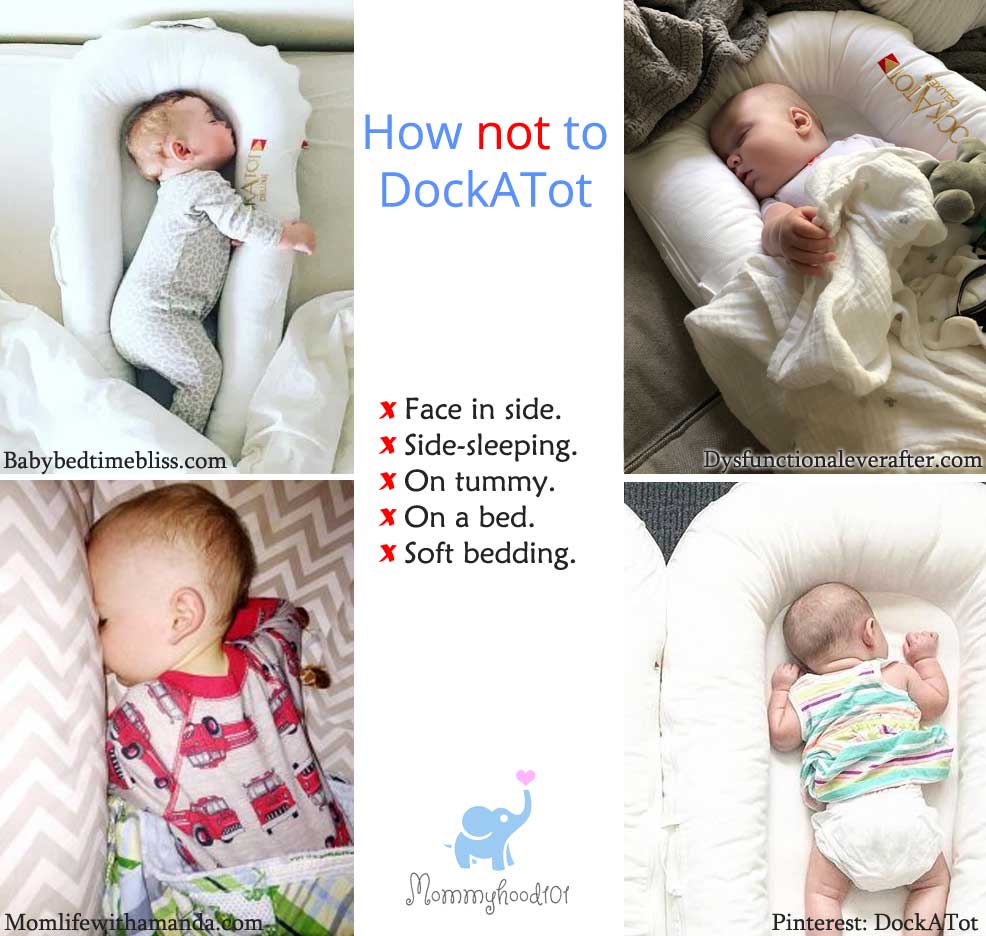
It's important to point out that most of these circumstances have nothing to do with the DockATot.
Indeed, regardless of where your infant is sleeping, they should not be on their tummy, have soft bedding, or have their face against anything (even if it's "breathable cotton"). This is why most modern bassinets use completely mesh sides to reduce risk, cribs use slats and bumpers are ill-advised, firm mattresses are used, and babies are isolated from the parents' sleeping arrangement.
Conclusions of our DockATot Review
Overall, we were impressed with the features and comfort of the DockATot, and it's definitely one of the best baby nests we've ever used.
Even without using it as a sleeper or co-sleeper, we found a ton of awesome and cozy uses for the DockATot, and think it's a great replacement for an activity mat (especially if you purchase one of the overhead toy arches). As an activity mat, it can be used for playtime, tummy time, and watching parents and siblings go about their routines.
But it goes beyond an activity mat in that you can bring it along easily to the beach, hiking, camping, or a picnic in the park. The walls give your baby a good sensory experience of being partially enclosed and secure, but also keep out other little things, like sand on the beach, bugs while camping, etc.
In this regard, the DockATot is pretty versatile, you simply need to use your imagination.
One big question remains: if you're not going to use the DockATot for sleeping or co-sleeping, is it still worth the cost? We'll let you be the judge, but we think it's pretty versatile and helpful. And if you're going to use it for supervised napping, babies find it super cozy and helpful for falling asleep and staying asleep.
Is the DockATot safe? It depends on how you use it. In our opinion, if you're using it as a baby lounge while your baby is awake, it's not only safe but super comforting and fun. Frankly, just don't do anything stupid with it: don't put it on the countertop or table, don't try to carry your baby in it, and don't use it for unsupervised sleep or co-sleeping. If you follow that guidance, YES, we believe it's safe for everyday use.
In contrast, if you're using it for unsupervised napping, co-sleeping, or nighttime sleeping, NO, we do not think it's safe. If you definitely are going to co-sleep, we suggest you invest in a bedside sleeper that attaches to the side of your bed but has a mesh wall separating you and your soft bedding from your baby's sleeping area. You can see our list of the best bassinets here. That's much safer for your baby and will help you both get safer sleep.









